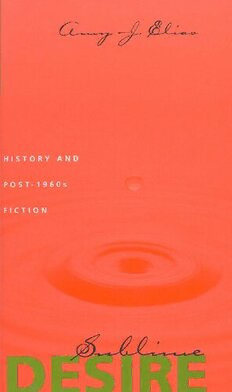
Sublime Desire History And Post PDF
Preview Sublime Desire History And Post
Sublime Desire - Stephen G. Nichols, Gerald Prince, and Wendy Steiner Sublime Desire History and Post- s Fiction Amy J. Elias The Johns Hopkins University Press Baltimore and London ©The Johns Hopkins University Press All rights reserved. Published Printed in the United States of America on acid-free paper The Johns Hopkins University Press North Charles Street Baltimore, Maryland - www.press.jhu.edu Library of Congress Cataloging-in-Publication Data Elias, Amy J., – Sublime desire : history and post-s fiction / Amy J. Elias p. cm. — (Parallax: re-visions of culture and society) Includes bibliographical references and index. ---(acid-free paper) . Historical fiction—History and criticism. I. Title. II. Parallax (Baltimore, Md.) . .′—dc - A catalog record for this book is available from the British Library. An earlier version of chapter appeared in Contemporary Literature , no. () under the title “The Postmodern Turn on the Enlightenment.” It is reprinted here, with revisions, by permission of the University of Wisconsin Press. Space and Time are the names of the exterminating angels that expelled us from Eden. They must be watched with great cunning. Only they can indicate to us the return path to the desired Gates. —Abel Posse, The Dogs of Paradise Facts are but the Play-things of lawyers,—Tops and Hoops, for-ever a-spin. . . . Alas, the Historian may indulge no such idle Rotating. History is not Chronology, for that is left to lawyers,—nor is it Re- membrance, for Remembrance belongs to the People. History can as little pretend to the Veracity of the one, as claim the Power of the other,—her Practitioners, to survive, must soon learn the arts of the quidnunc, spy, and Taproom Wit,—that there may ever continue more than one life-line back into a Past we risk, each day, losing our forebears in forever,—not a Chain of single Links, for one broken Link could lose us All,—rather, a great disorderly Tangle of Lines, long and short, weak and strong, vanishing into the Mnemonick Deep, with only their Destination in common.” —Thomas Pynchon, Mason & Dixon Kant begins his logic, his last book, by saying that “the source of all error is metaphor.” Well, too bad. He is wrong. Metaphor is maybe the source of all error but it is also the source of all truth, too. —Hayden White Contents Preface ix Introduction xvii Theory Sorting Out Connections: The Historical Romance in Hyper-reality The Metahistorical Romance and the Historical Sublime Analysis Cracking the Mirror: Spatializing History in Metahistorical Romances Metamodernity: The Postmodern Turn on the Enlightenment Western Modernity versus Postcolonial Metahistory Coda:The Sot-Weed Factorand Mason & Dixon Appendix: A Listing of Some Metahistorical Romances Notes Works Cited Index vii Preface The present volume examines late-twentieth-century examples of the historical novel in relation to recent postmodern cultural assump- tions and the traditional historical novel form, which was (at least in Walter Scott’s novels, the most famous case) predicated on epistemo- logical and historiographical assumptions of the Age of Reason. By examining only novels published after in “First World” nations, I assume cultural and aesthetic definitions of postmodernism as a post- social phenomenon and artistic sensibility. By examining these texts in relation to the historiography of their time, this study upholds the assumptions of cultural critics who claim that postmod- ernism is the zeitgeist of postindustrial, late-twentieth-century capi- talism. Likewise, by almost exclusively examining novels by authors from the United States, Great Britain, Australia, and Canada, I high- light the difference between First World postmodernist literature and literary movements and developments outside of these nations, such as the development of postcolonial literature or the perpetuation of underground political arts movements throughout the world. Fredric Jameson was correct to identify postmodernism with late capitalism, and this study assumes, for example, that while it is possible to dis- cuss Charlotte Brontë’s feminist or politically oppositional sensibility, it is not accurate to discuss her “postmodernism.” Perhaps contradic- torily, however, my linking of these post-novels to the historical novel tradition illustrates how these novels are also postmodern in an epistemological sense, for they almost always criticize, undermine, complicate, or try to position themselves against the precepts of En- lightenment modernity. The novels I consider are primarily those originally written in En- ix
